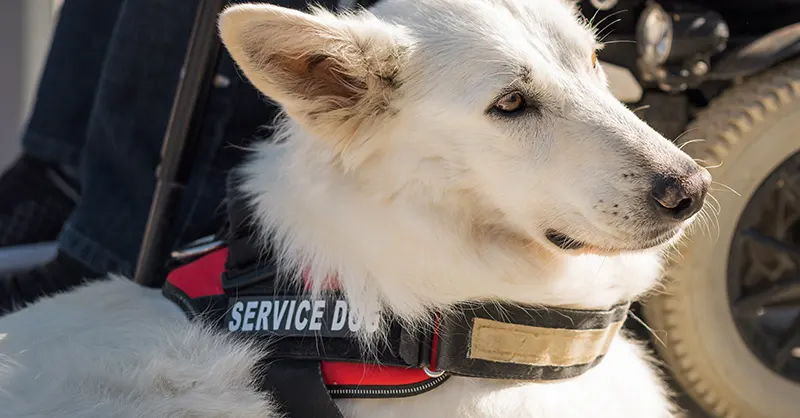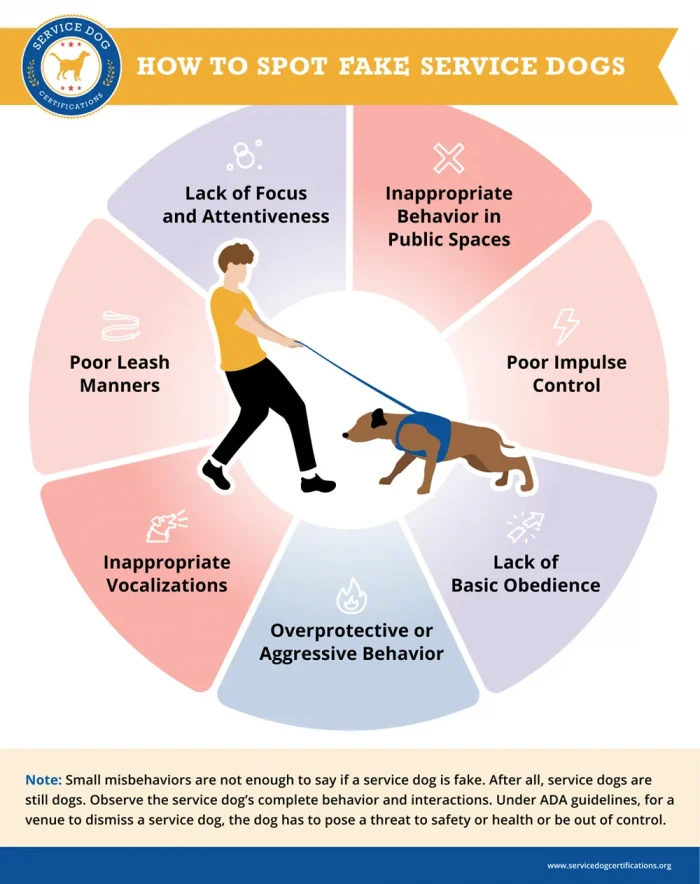How to Spot Fake Service Dogs

If you suspect someone is lying about having a service dog, there are ways to tell whether the person is being truthful or not without violating the Americans with Disabilities Act. You can separate real service dogs from fake ones by knowing a few rules, observing the dog’s behavior, and questioning the owner.
In this guide, our ADA experts will teach you how to spot a fake service dog while avoiding trouble for infringing on service dog owner rights.
- Behaviors that Indicate a False Service Dog
- Handler Actions that Indicate a False Service Dog
- Common Mistakes in Identifying Fake Service Dogs
- Emotional Support Animals versus Service Dogs
- Penalties for Pretending to Have a Service Dog
Behaviors that Indicate a False Service Dog
A service dog needs special training to perform a task related to the handler’s disability. Service dogs also have to be trained to behave in public settings (sometimes even passing a public access test). A venue can request that a service dog leave the premises if it is acting aggressively or causing property damage.
Here are some behaviors to look for if you think a service dog is not real:
1. Lack of Focus and Attentiveness
A legitimate service dog should maintain constant awareness of their handler and respond quickly to commands or changes in the handler’s condition. Non-service dogs may appear distracted, unfocused, or overly interested in their surroundings rather than their handler. Keep in mind, though, that service dogs, like normal dogs, are sometimes set free for playtime.
2. Poor Leash Manners
Service dogs should be able to calmly walk beside their handler, typically on a loose leash without pulling. If the dog is pulling on the leash, zigzagging, or struggling to maintain a consistent walking pace with their handler, it may not be properly trained.
3. Inappropriate Vocalizations
Most service dogs remain quiet unless performing a specific task that requires barking (like alerting a blind individual to danger). If the dog frequently barks, growls, whines, or makes other noises without any apparent purpose, that should raise your suspicions.
4. Inappropriate Behavior in Public Spaces
Service dogs are trained to be calm and composed in various environments, including crowded or noisy places. Non-service dogs might show signs of stress, aggression, or fear in public settings, such as growling, excessive panting, or attempting to hide.
5. Poor Impulse Control
Service dogs can resist temptations like food on the ground, other animals, or interesting smells when they are on duty. If you see that the handler cannot control their dog from lunging for food, becoming overly excited by scents, or trying to interact with other animals, it might not be a service dog.
6. Lack of Basic Obedience
A minimum requirement for service dogs is the ability to respond promptly to basic commands like sit, stay, and come. If you see a dog that ignores basic commands, it may not be a service dog.
7. Overprotective or Aggressive Behavior
Service dogs are trained for public access. That means remaining neutral towards other people and animals unless performing a specific protective task. Service dogs should never display overprotective behaviors, growl at strangers, or show aggression toward other animals or people.
Note that, in all these instances, small misbehaviors are not enough to say if someone’s service dog is fake. For example, pulling slightly at the leash, getting excited, or becoming slightly distracted is normal, even for a service dog. After all, service dogs are still dogs, and, like their human companions, they are not 100% perfect.
You should try to observe the service dog’s complete behavior and interactions with the owner. Under ADA guidelines, for a venue to dismiss a service dog, the dog has to pose a threat to safety or health or be out of control.
Share this image on your site
Handler Actions that Indicate a False Service Dog
As a venue staff member, a landlord, or an airline agent, you’re allowed to ask two questions under the ADA to verify if someone has a service dog: 1. Is the dog a service dog required for a disability? and 2. What work or task has the dog been trained to perform?
These are the ONLY questions that can be asked to confirm someone has a service dog. If they can’t answer both questions, you have the right not to let the dog enter. Keep in mind that you can’t ask specific questions about a person’s disability or ask the dog to demonstrate its task.
Even if the handler shows you a service dog ID card, certificate, tag, or vest, you can still rely on the two questions. Service dog owners use these items to signal that their dog is a service animal, but they don’t exempt them from having to answer the ADA verification questions.
Some people wonder why they can’t ask more specific questions. Others have proposed that service dog ID cards and registrations become mandatory. The reason is that service dog laws have to respect the privacy of service dog owners and should not burden them with obstacles.
The vast majority of dog owners act ethically and do not pass their dogs off as service dogs. It would be unjust to punish service dog handlers by subjecting them to probing questions or documentation requirements just because of a few bad apples.
Common Mistakes in Identifying Fake Service Dogs
These are NOT reasons to assume a service dog is fake:
- When the dog is small: Not all service dogs are Golden Retrievers, Labradors, or German Shepherds! Service dogs come in all shapes and sizes. Sometimes, smaller service dogs are better suited to the owner’s lifestyle. For example, a lap dog can be perfect for someone who needs a psychiatric service dog but lives in a small apartment.
- When the person doesn’t have an obvious disability: Never assume a service dog is fake because the handler doesn’t “look” disabled. Many serious disabilities are not visible, especially psychiatric conditions.
- When the service dog has no vest, ID card, or tags: Most service dogs wear vests, tags, and ID cards so others can easily spot them. But they are not mandatory! You should never assume a service dog is fake just because they lack these items.
- When there is more than one dog: Some people think owners with two service dogs are faking it, but the ADA recognizes people who need more than one dog. It is not uncommon for someone to have one dog trained for one need and another trained for a separate health issue.
- When the dog is a mixed breed: Service dogs are not just pure breeds. Shelter and rescue dogs also serve as capable service dogs. Under the ADA, there are no breed limitations when it comes to service dogs.

Emotional Support Dogs Pretending to be Service Dogs
It’s not entirely accurate to call emotional support animals “fake service dogs”. ESAs are also legally recognized assistance animals that help people with mental health disabilities. There is certainly nothing fake about their importance to people with mental illness.
However, if a person comes into a store or other venue like an airport claiming they are not subject to no-pet rules because they have an emotional support dog — they are wrong. ESAs only have housing rights. Emotional support animals are not the same as service dogs and do not have the same rights under the ADA.
Many people make the honest mistake of not realizing the legal differences between emotional support animals and service dogs. If someone tries to bring their ESA into a no-pets zone, you can gently inform them that while your establishment gladly welcomes service dogs, emotional support animals are not the same thing.
Penalties for Pretending to Have a Service Dog
Many states have taken the initiative to create laws that address service dog fraud. These laws should further discourage people from pretending that their pet is a service dog. Here are some examples of state laws and their penalties:
- California Penal Code 365.7: Knowingly and fraudulently representing a dog as a service dog is classified as a misdemeanor
- Florida Statute 413.08(9): Misrepresenting an animal as a service animal is a second-degree misdemeanor
- Texas Human Resources Code, Title 8, Chapter 121.006: Intentionally or knowingly representing that an animal is a service animal when the animal is not specially trained or equipped to help a person with a disability is a misdemeanor.
- Washington RCW 49.60.214: Misrepresenting an animal as a service animal is a civil infraction.
Balancing Awareness with Respect
While it’s important to be aware of potential fake service dogs, it’s equally important to approach the situation with sensitivity and respect. Remember:
- Not all disabilities are visible.
- Service dogs can be trained for a wide variety of tasks and disabilities.
- The ADA limits the questions that can be asked about a service animal.
- Focus on the dog’s behavior rather than making assumptions about the handler.
By understanding the behavioral indicators and legal rules surrounding service dogs we can better support those who genuinely need these amazing assistants while discouraging fraudulent misrepresentation.
About the Author: The writing team at Service Dog Certifications is made up of folks who really know their stuff when it comes to disability laws and assistance animals. Many of our writers and editors have service dogs themselves and share insights from their own experiences. All of us have a passion for disability rights and animals.
2 comments
Leave a Reply Cancel reply
Latest Posts

Dangerous Materials Hiding in Your Dog Products
Jake’s German Shepherd began developing strange rashes around his collar. Three vet visits later, they figured out the leather was treated with chromium — a chemical that irritates sensitive skin. Jake had no idea his dog’s collar contained industrial chemicals. Most dog owners don’t know what goes into the products they buy. Many companies use […]

Read More

Can You Bring a Service Dog to a Basketball Game?
Yes, you absolutely can bring your service dog to basketball games. Whether you’re heading to your local high school tournament, a packed college rivalry game, or splurging on NBA tickets, the Americans with Disabilities Act protects your right to be accompanied by your service dog anywhere the public can go. When you arrive, venue employees […]

Read More

Best Pet Health Insurance Providers
If you own a pet, you know how important — and expensive — vet care can be. One way to offset those costs is to purchase pet health insurance. Like typical health insurance, pet insurance is available at many price points, and can cover all, most, or only some of your vet-related costs. It can […]

Read More

If my doctor trains her own dogs for low glucose in diabetics, do those dogs also have to go to proper training?
If your question is whether your doctor can self-train her own service dogs, then yes, the ADA allows for handlers to completely train a dog on their own. You are never required to hire a professional trainer. Let us know if that was helpful!